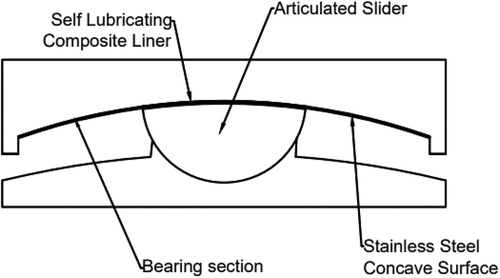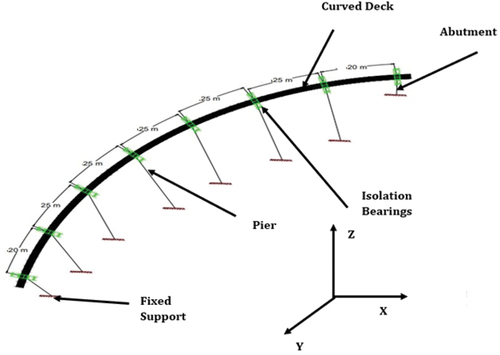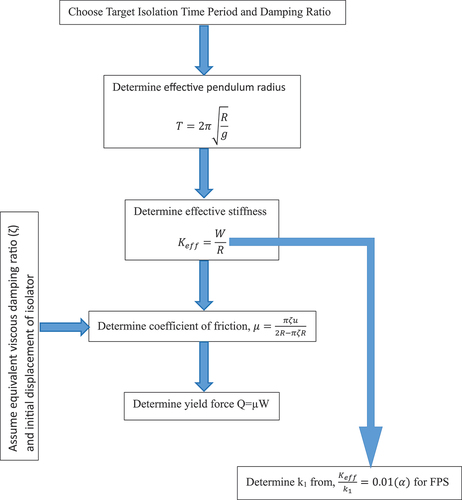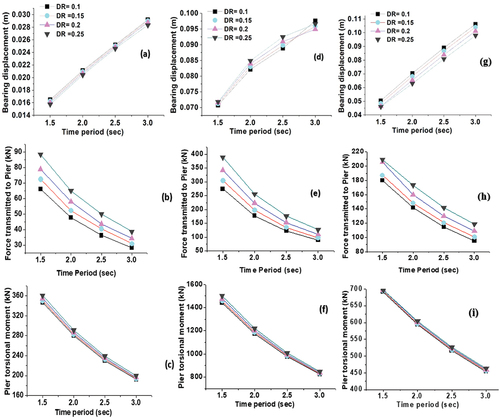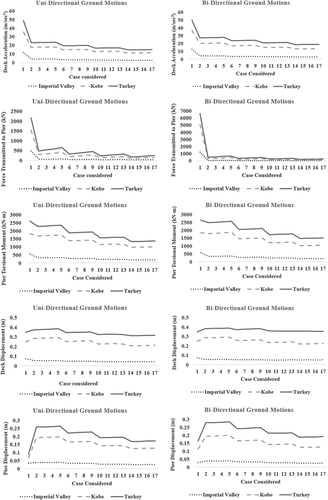 ?Mathematical formulae have been encoded as MathML and are displayed in this HTML version using MathJax in order to improve their display. Uncheck the box to turn MathJax off. This feature requires Javascript. Click on a formula to zoom.
?Mathematical formulae have been encoded as MathML and are displayed in this HTML version using MathJax in order to improve their display. Uncheck the box to turn MathJax off. This feature requires Javascript. Click on a formula to zoom.ABSTRACT
The friction pendulum system (FPS) is a crucial tool for seismic protection. However, effectiveness in curved bridges, especially controlling torsional moments (TMs), has not been thoroughly assessed. This study evaluates how well a continuously curved bridge equipped with FPS performs under various earthquake loadings. The study assesses FPS efficiency, considering factors like multidirectional impacts, seismic motion strength, incidence angle variations, and ground motion characteristics. Finite element modeling of the bridge structure was conducted using SAP2000v20 Finite Element Analysis software. Three earthquake scenarios (near fault, far fault and forward directivity) were considered. The study also examines the bidirectional behavior’s impact on the bearing and pier interaction. A sensitivity analysis was performed for the bridge response concerning bearing design parameters for each earthquake scenario. The results show that FPS bearings significantly reduce the bridge’s seismic response. Bidirectional excitation was found to be critical for curved bridges, increasing displacement compared to unidirectional motion. Under unidirectional excitation, the isolated bridge with FPS reduces TMs by approximately 26–54%. In bidirectional excitation, FPS remains effective, reducing TMs by about 14–43%. This study underscores the importance of FPS in enhancing seismic resilience, particularly in controlling torsional responses in complex, curved bridges in varying seismic conditions.
1. Introduction
Bridges are regarded as an essential component of transportation networks, and consistent performance is predicted even during violent ground vibrations (Giresini Citation2022; Solarino and Giresini Citation2021; Vatanshenas and Sadegh Citation2020). Isolation is a technique that tries to lower the earthquake forces to or close to what the structure can handle elastically (Giresini et al. Citation2021; Wang et al. Citation2020; Zheng et al. Citation2019a). Seismic base separation reduces seismic demand and improves seismic performance. Seismic isolation has been found to improve seismic performance and decrease damage during strong earthquakes. Previous research has demonstrated the significance of isolation bearings since they play a critical role in facilitating the transmission of forces from the superstructure to the substructure (Gudainiyan and Gupta, Citation2023b; Labiba and Muntasir (Citation2020); Wang et al., (Citation2021). Friction pendulum system (FPS) is frequently used in bridges for the purpose of seismic isolation because of its ability to offer steady lateral stiffness and consistent isolation duration. By restricting the earthquake stresses of crucial structural parts to or near the elastic limit, regular FPS may avoid or decrease bridge deterioration and inelastic deformation (Wang et al. Citation2021, Citation2023; Zheng et al. Citation2019b). The concave design and surface friction qualities of the FPS make it an effective seismic isolation bearing. The housing plate slides on the concave dish and releases hysteresis energy through friction, putting the supporting structure into a pendulum motion (Agrawal, Gupta, and Ghosh Citation2023; Eröz and DesRoches Citation2013; Gudainiyan and Gupta Citation2023a).
The FPS has three main components, ie, a housing plate, an articulated slider, and a concave spherical dish made of stainless steel. A composite material with low friction has been applied to the articulated slider’s side that faces the spherically concave surface (Wang, Zhou, and Shi Citation2023a, Citation2023b). The slider has a stainless-steel finish on the other side and rests in a low-friction composite-lined sphere. By moving the slider on the concave spherical surface, the supported mass rises and provides restoring force to the system. The articulated slider’s interaction with the circular surface creates dampening within the isolator.
Because of its geometric design, FPS provides an effective frictional isolation system by combining sliding motion with restoring force. is a diagram of a simplified version of the FPS, it consists of a slider that moves on a circular surface made of stainless steel. A composite material having low friction is applied to the articulated slider’s side that makes contact with the spherical surface. One side of the slider is spherical, has a coating of stainless steel, and rests in the sphere, which is covered with composite material whose friction is low (Wang et al. Citation2022, Citation2023; Zhang, Wang, and Shi Citation2023). The supported mass is raised as the slider is moved across the sphere, providing the restoring force for the system. The damper in the isolator comes from the friction between the flexible slider and the circular surface (Kumar et al. Citation2023; Naeim and Kelly Citation1999; Wang et al. Citation2022).
Zayas, Low, and Mahin (Citation1987) reported the usefulness of FPS as an isolation system, and later on, it was used in bridges (Constantinoli et al., Citationn.d.1993; Dicleli and Mansour Citation2003; Tsopelas et al. Citation1996). Zayas, Low, and Mahin (Citation1990) stated that the possibility of torsional coupling in asymmetric structures could be reduced by using the FPS because, in this system, both restoring force and frictional force are proportional to the weight of the structure, hence the centre of mass and centre of rigidity will coincide. MOKHA et al. (Citation1991) stated that the force resisted by the FPS depends on the velocity of sliding since the coefficient of sliding friction is velocity-dependent. A method has been developed by Wang, Chung, and Liao (Citation1998) for the dynamic analysis of structures using the FPS. In the method, a single motion equation has been adopted for the system’s stick and slip modes. The method has been verified for a continuous three-span bridge exposed to real earthquakes and harmonic motions. Mutobe and Cooper (Citation1999) and Ingham (Citation2003) presented the modelling of FPS by node-to-node frictional contact surface elements. The main difference between the two studies was that in the former case, spherical contact surface elements were used, whereas in the latter case, flat contact surface elements were considered. A bilinear model of the FPS has also been proposed by many researchers.
An enhanced base isolation device composed of a standard friction pendulum bearing (FPB) and viscous damper (VD) was proposed to accomplish the seismic resilience design of the structure during earthquakes (Chen, Wu, and Li Citation2022; Wang et al. Citation2019). The experimental findings demonstrate the effectiveness of the suggested FPB-VD device in lowering the acceleration and deformation requirements of the prototype system in comparison to those of traditional FPB (Wang et al. Citation2019, Citation2020). Castaldo, Palazzo, and Della Vecchia (Citation2015) assessed the seismic dependability of a friction pendulum isolated base structure by treating the features of the isolators (ie, the coefficient of friction) and the primary characteristics of earthquakes as independent random variables. Kim and Yun (Citation2007) investigated the trilinear behaviour of a double concave friction pendulum system (DCFP). The DCFP is made up of two sliding surfaces, each of which has a unique friction coefficient and a variable curvature radius. The primary level of displacement resulting from the earthquakes occurs within the isolation layer, while the superstructure maintains its elastic properties and exhibits rigid body motion. Hence, it is imperative for the base isolation system to possess the capacity to endure substantial displacement, thereby becoming crucial in terms of its design and implementation (Chen, De Domenico, and LI Citation2023; Li et al. Citation2021). The consequences of an earthquake on a cable-stayed bridge with single concave FPBs were investigated (Atmaca, Yurdakul, and Ateş Citation2014). Faramarz and Montazar (Citation2010) investigated the influence of an earthquake’s vertical component on the reaction of base-isolated structures using a DCFP device. The pendulum tuned mass damper is commonly employed as a passive damper, incorporating a frequency adjustment mechanism and vibration control system. Nevertheless, this particular device exhibits a high degree of sensitivity towards frequency fluctuations and presents challenges in terms of frequency adjustment (Cao and Li Citation2022; Wang et al. Citation2020).
From the above literature, it was observed the various researchers have investigated the different aspect of the FPS with bridges. It was observed that the friction pendulum has significantly reduces the response of the bridge under different seismic loading conditions. However, it has also been observed that the effect of incidence of earthquake on the response of the bridges has not been well investigated. Also, the application of FPS has been studied for straight bridges, but, in case of curved bridges, the effectiveness of FPS has not been well investigated, especially from the point of view of controlling torsion which is supposed to be a crucial design consideration for curved bridges. It was also observed that previous studies have not included the effect on the response of curved bridge with bi-directional ground motion.
2. Modelling
The research considered the longitudinally curved RC bridge () with a curvature radius of 315 m (Gupta and Ghosh Citation2021, Citation2021; Yu et al. Citation2008). The bridge is made up of seven spans, five of which are 25 m long and one of which is 20 m long. The bridge’s overall length is 165 m. The superstructure is made up of a box girder that has a constant section and is 3.099 m2 in size. It has a longitudinal moment of inertia that measures 0.5989 m4. M40-grade concrete has been taken into consideration. All of the pillars are constructed out of M30-grade concrete, and each one stands 11 m tall with a circular cross-sectional area of 1.7671 m2. As stirrups, we use spiral reinforcement (20d) with a spacing of 10 cm, and we use continuous reinforcing bars (15 φ 28 mm) with a cover layer thickness of 5 cm (Gupta et al. Citation2022).
The model of the bridge has been created with the help of the finite element programme in SAP 2000 v20 (Computers and Structures, I Citation2021). The superstructure of the bridge as well as the piers have been simulated using beam elements, and the masses have been focused at discrete places. Piers have been provided with fixed support as it is believed that they are supported on rock. It is presumed that the abutments are rigid. FPS is modelled as a link element. Coupled plasticity behaviour (EquationEquations 1–(1)
(1) Equation4
(4)
(4) ) of FPS has been assigned to the link elements, and design steps are depicted in the flowchart. Three parameters are important for the design of the FPS, ie, the period of the isolated structure, the damping of the isolation bearing, and the level of ground movement. displays the force-deformation behaviour of the FPS. Roller support is provided to the bridge at the abutments, and fixed support is provided at the piers. There are two FPSs at the position of the bridge abutments and four FPSs between the deck and the piers in the case of an isolated bridge.
Due to the curved bridge, the responses are taken in the X and Y directions. In the study, the lumped plastic model was taken into account. When using the finite element method, segments or elements are created automatically by SAP 2000, with the mass concentrated at discrete points between them. In SAP 2000, mass distribution is taken into account automatically. To provide a rough estimate of the mass distribution with concentrated mass, a significant number of nodes and segments (units) must be defined. ATC-32 (Box et al. Citation1996; Gupta et al. Citation2022) states that each superstructure span must have at least four segments and piers must have at least three segments. In this work, deck has been represented by using 20 elements for a 20 m span, 25 segments for a 25 m span, and 11 elements for piers. Plastic hinges have been taken into account to consider nonlinearity in the pier, and the hinge characteristics have been taken into account using a concentrated plastic model in accordance with FEMA 356 (Emergency and Agency Citation2000).
Mechanical characteristics of FPS is given as followings
The resistive force F is determined by
where D is horizontal displacement, W is load on FPS, µ is friction coefficient, and R stands for radius of curvature of dish.
Horizontal stiffness provided by restoring force is given as follows:
which results in an isolated structure with period T given by
The equivalent stiffness is calculated as follows:
The damping produced by friction at the sliding surfaces can be estimated by the code formula
3. Parametric study
A sensitivity study of the bridge response for varying time periods and damping ratios has been performed. For this purpose, the time period range has been considered as 1.5–3 s, and the range of damping for FPS has been selected as 0.1–0.25. The response of the bridge has been studied for seismic loading. For the seismic loading, recorded ground motions have been applied without scaling.
shows the three recorded earthquake motions from the PEER database (Berkeley Citation2014; Prasanth et al. Citation2023; Sekar et al. Citation2023) that have been taken into consideration: (1) Imperial Valley (G.M. 1), (2) Kobe (G.M. 2), (3) Turkey (G.M. 3), each with two horizontal components. The chosen ground movements reflected the situations far fault, near fault, and forward directivity effects, respectively.
Table 1. Parameters of selected ground motions.
4. Results and discussions
The sensitivity analysis of the bridge was performed for different time periods (TP) and damping ratios (ζ) with varying incident angles (θ) of ground motions, and the seismic response has been determined for the bridge structure under both unidirectional and bidirectional ground excitations. The torsional moment (TM), deck acceleration (DA), and force transferred to the pier (FTP) are the principal response factors taken into consideration.
4.1. Effect of incidence angle (θ)
Incidence angle (θ) plays a significant role in the case of curved bridges due to the possibility of an increase in the TM. Response in both horizontal directions is being considered in the design of the bearing.
shows the response of the bridge with varying incidence angles of 0º–90º for G.M.-1, G.M.-2, and G.M.-3, respectively, due to unidirectional loading. The variation of all the response parameters of the bridge w.r.t. the incidence angle of the earthquake is nonlinear. It has been found that the DA and TM attain maximum values of response at an incidence angle close to 90°. In the case of FTP and bearing displacement, the variation with varying incidence angles is found to be very less.
Figure 4. Response of bridge to unidirectional (a–c) and bidirectional (d–f) G.M.-1, G.M.-2, and G.M.-3 at different incident angles.

shows the response of the bridge with varying incidence angles of 0º–90º for bidirectional loading. It has been found that DA attains its maximum value of response at an incidence angle close to 0º. The variation in bearing displacement and TM for varying incidence angles is found to be very less for all ground motions. TM decreases up to 45º and increases after that for the Kobe earthquake.
4.2. Response sensitivity
During the sensitivity analysis, the variance of the maximum response of the bridge for the selected range of the design parameters for many different types of bearings has been studied.
demonstrates how the bridge’s response varies with the damping ratio for unidirectional loading of G.M.-1, G.M.-2, and G.M.-3, respectively. The figures show that the response parameter’s fluctuation in relation to the damping ratio is nonlinear. It is observed that the bearing displacement has minimal variation with increases in the damping ratio. It may be due to the high initial stiffness of the isolation system. The TM and FTP increase as the damping ratio increases. This may be due to the fact that the yield force of the isolation system increases with an increase in the damping ratio for all earthquake motions.
Figure 5. Response of bridge under unidirectional G.M.-1 (a-c), G.M.-2 (d-f) and G.M.-3 (g-i) due to different damping ratios of FPS.

depicts the bridge’s response with time periods for unidirectional loading of G.M.-1, G.M.-2, and G.M.-3, respectively. The figures revealed that the variation of response parameters (bearing displacement and TM) with respect to time period is nonlinear. However, it has also been found that the pier displacement increases with the increase in TP. This may be due to the fact that post-yield stiffness decreases as the TP increases. Also, it has been found that the isolation time period (2.5–3.0 s) gives a lower TM and FTP for all ground motions.
Figure 6. Response of bridge under unidirectional GM-1 (a–c), GM-2 (d–f) and GM-3 (g–i) due to different time periods of FPS.
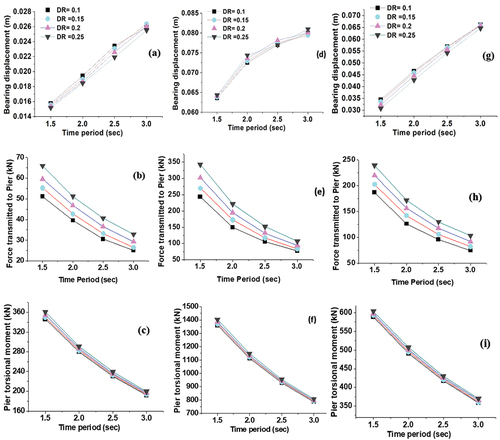
shows the variation of the bridge response for damping ratio for bidirectional loading of GM-1, GM-2 and GM-3 earthquakes, respectively. From the figures, it has been found that the variation of the response parameter w.r.t. TP and ζ is nonlinear. It has been observed that bearing displacement varies with the damping ratio insignificantly. This may be due to the high initial stiffness of the isolation system. The TM and FTP increase as the damping ratio increases; this might be due to the fact that the yield force of the isolation system increases with an increase in the damping ratio for all earthquake motions.
Figure 7. Response of bridge under bidirectional GM-1 (a–c), GM-2 (d–f) and GM-3 (g–i) due to different damping ratios of FPS.
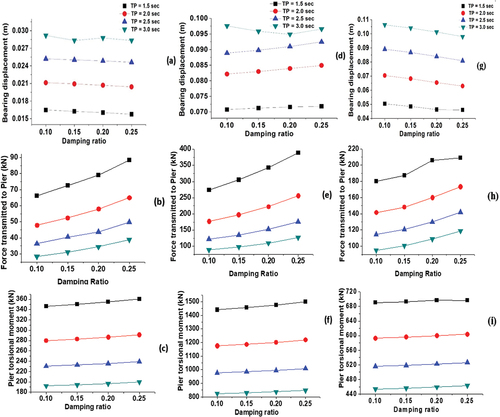
shows the variation of the bridge response for varying TP for bidirectional loading of GM-1, GM-2 and GM-3, respectively. From the figures, it has been found that the variation in bearing displacement and TM w.r.t. time period is nonlinear. However, it has also been observed that the pier displacement increases with the increase in the isolation TP. This may be due to the fact that post-yield stiffness decreases as the TP increases. It has been found that the isolation time period (2.5–3.0 s) gives a lower TM and FTP for all earthquake motions.
4.3. Non-isolated vs. Isolated bridge response
G.M.-1, G.M.-2 and G.M.-3’s isolated and non-isolated bridges’ peak responses for unidirectional and bidirectional motions are shown in (. provides an overview of various cases.
Table 2. Different cases that were taken into consideration to compare the response of the bridge to a non-isolated condition.
It has been found that the FPS has reduced the TM, FTP, and DA significantly compared to the non-isolated case for both unidirectional and bidirectional cases for all ground movements taken into consideration.
For unidirectional GM-1, TM, DA, FTP, deck displacement, and pier displacement have been decreased by 42%–66%, 66%–78%, 89%–93%, 28%–43%, and 26%, respectively, compared to a non-isolated bridge. In the case of unidirectional GM-2, it has been found that the DA, FTP, and TM have been decreased by 43%–63%, 77%–90%, and 35%, respectively, compared to a non-isolated bridge. It has been observed that the FPS is able to reduce the DA, FTP, and TM by 59%–72%, 70%–84%, and 26%–54%, respectively, for a unidirectional Turkey earthquake.
For bidirectional GM-1, the DA, FTP, TM, and deck displacement have been reduced by 68%–77%, 95%–97%, 40%–65%, and 28%–33%, respectively, compared to a non-isolated bridge. In the case of bidirectional GM-3, it has been found that the DA, FTP, and TM have been decreased by 33%–57%, 93%–97%, and 33%, respectively, compared to a non-isolated bridge. It has been observed that the FPS is able to reduce the DA, FTP, and TM by 45%–58%, 88%–92%, and 14%–43%, respectively, for a bidirectional Turkey earthquake.
4.4. Bidirectional loading effect
The isolated bridge’s peak response for varied ground movements is shown in . For the considered earthquake motions, it was discovered that the impact of bidirectional ground motion is significant.
Figure 10. The unidirectional and bidirectional ground motion response characteristics for the isolated curved bridge.

It is also observed that DA, deck displacement, and TM have increased by 13.52 %, 18.60 %, and 6.18 %, respectively, under bidirectional loading for GM-1. It is also observed that DA, deck displacement, and TM have increased by 20.34%, 4.95%, and 9%, respectively, under bidirectional loading for GM-2. It is also observed that DA, deck displacement, and TM have increased by 50%, 61%, and 31%, respectively, under bidirectional loading for the Turkey earthquake.
represents the FTP and bearing displacement of a curved bridge due to unidirectional and bidirectional loading. It was also found that for all ground motions, the response envelope caused by bidirectional loading (red line) was significantly larger than that caused by unidirectional loading (black line).
Figure 11. Response envelopes of the isolated bridge for GM-1 (a and b), GM-2 (c and d), and GM-3 (e and f).
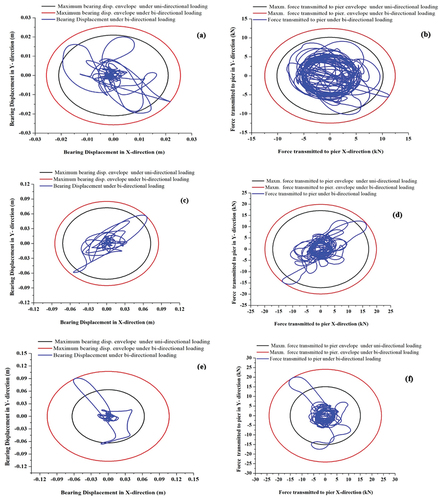
The maximum rise in response parameters due to Imperial Valley bidirectional loading has been observed for the combination of an isolation TP of 2.5 sand ζ of 0.25. It has been observed that due to bidirectional loading, the FTP and bearing displacement have increased by 18.12% and 18.2%, respectively.
The maximum increase in response parameters due to Kobe bidirectional loading has been observed for the combination of an isolation TP of 3.0 s and ζ of 0.1. It has been observed that due to bidirectional loading, the FTP and bearing displacement have increased by 21.6% and 22.5%, respectively.
The maximum increase in response parameters due to Turkey bidirectional loading has been observed for the combination of isolation time period of 3.0 s and damping ratio of 0.1. It has been observed that due to bidirectional loading, the FTP and bearing displacement have increased by 64% and 61%, respectively.
5. Conclusion
Under seismic loading, the response of the bridge with an FPS has been determined. Three different types of ground motions have been considered, and the effect of an earthquake’s incidence angle on the bridge’s response has been studied. A sensitivity analysis has been performed to investigate the response variation w.r.t. the isolator design parameters. The importance of the bidirectional loading effect on how the bridge reacts has also been studied. Some crucial points are highlighted as follows:
The FPS bearings have been found to reduce the bridge’s response in a significant manner under various seismic loading conditions considering near-fault, far-fault, and forward directivity effects. This has been found to be the most important advantage of FPS bearings, even for the curved bridge where the torsion effect will be a crucial factor.
It is also observed that the variation of the incidence angle of the earthquake w.r.t. the response parameter is nonlinear under unidirectional and bidirectional loading for all earthquake motions that were taken into consideration. It can be observed that the TM is significantly influenced by the incidence angle in addition with the directional excitation effect as in most of the cases, there are variation of TM w.r.t. variation of angle of incidence.
It has been found that in the case of unidirectional and bidirectional loadings, the maximum seismic response of the bridge occurred at an incidence angle of 90º and 0º, respectively, for all the considered ground motions.
Sensitivity analysis of the bridge with FPS bearings shows that the variations of the FTP and TM w.r.t. damping ratio and time period are nonlinear for all the ground motions under both unidirectional and bidirectional loading conditions. However, the variations in bearing displacement have not been found to be so pronounced. It has also been observed that the minimum value of the DA has occurred at an isolation time period range of 2.5–3.0 s.
It has been observed that bidirectional loadings significantly increase the response of the bridge with FPS bearings as compared to unidirectional loadings. Bearing displacement and FTP were determined to rise the most for the Turkey earthquake and the least for the Imperial Valley earthquake.
It has been observed that in the case of near-fault ground motion with forward directivity effect, ie, for Turkey ground motion, FPS system can be a good choice in terms of reduction of displacement and force transmitted to the pier.
It has been observed that in the case of Turkey ground motion, the effect of bidirectional loading on the response of the bridge is found to be more pronounced. This might be due to the forward directivity effect of near fault motions for the Turkey ground motions.
The variation of incidence angle of the earthquake affects the response of the bridge mostly under the Turkey bidirectional loading, which might be due to forward directivity effect of Turkey ground motion.
The proposed FPS is a passive control system, while semi-active and adaptive control system will have a better energy dissipation and earthquake mitigation effect. However, semiactive and adaptive FPS for curved bridge will be investigated in future study.
Acknowledgements
The corresponding author wishes to extend gratitude to all the authors who made valuable contributions to the successful completion of the research.
Disclosure statement
No potential conflict of interest was reported by the author(s).
Data availability statement
The data that support the findings of this study are available from the first named author, upon reasonable request. Any such requests should be made by emailing the first named author directly.
Additional information
Funding
Notes on contributors
Praveen Kumar Gupta
Dr. Praveen Kumar Gupta is an assistant professor in the department of civil engineering at the National Forensic Sciences University, Gandhinagar, Gujrat, India, under the Ministry of Home Affairs, Government of India.
Suyesha Agrawal
Suyesha Agrawal is a Ph.D Scholar in the department of Civil Engineering at GLA University, Mathura.
Goutam Ghosh
Dr. Goutam Ghosh, is currently an Associate Professor in Civil Engineering Department, MNNIT Allahabad, Prayagraj, India. He did his Ph.D. from IIT Roorkee in the area of seismic performance of bridge structures. He has more than 12 years of teaching experience and has published several research papers in reputed Journals/Conferences. His area of interest is earthquake engineering, performance-based design of structures, base isolation of structures, and bridge engineering.
Prasanth S
Dr. Prasanth S, as an Assistant Professor at the Centre for Disaster Mitigation and Management (CDMM) at Vellore Institute of Technology (VIT), has a research experience of almost 5 years in the area of seismic resilience and risk assessment of buildings. In pre-doctoral research, Dr. Prasanth worked as a structural design engineer for two years in various constriction companies like STUP Consultants and L&T Infrastructure Engineering. His entire research focuses on the development of resilient community towards disaster events. He has published various research articles related to resilience assessment of various building types in SCI/Scopus-indexed journals, conferences, and book chapters.
Virendra Kumar
Dr. Virendra Kumar is currently serving as an Assistant Professor in the Department of Mechanical Engineering at Harcourt Butler Technical University, Kanpur, India. He holds a Ph.D. in Thermal Engineering, which he obtained from the prestigious Indian Institute of Technology, Delhi, India. With more than 9 years of experience in teaching and research, Dr. Kumar is recognized for his significant contributions as an inventor with seven patents to his name. He has authored over 55 research articles in peer-reviewed journals, showcasing his expertise in the field. Dr. Kumar has successfully led central government-funded and state government-funded projects. He has also served as a member of editorial boards and a reviewer in several peer-reviewed journals. His research interests primarily lie in thermofluids, fluid power, ejector technology, and free jet flows.
Prabhu Paramasivam
Dr. Prabhu Paramasivam is a highly experienced mechanical engineering university teacher with over 10 years of teaching experience. He received his Bachelor’s and Master’s degrees in Mechanical Engineering from Anna University, India, and a Ph.D. in Mechanical Engineering from Himalayan University, India. Dr. Prabhu Paramasivam began his academic career as a Lecturer at Adama Science and Technology University, Ethiopia, where he taught undergraduate Mechanics and Materials Science courses. After completing his Ph.D., he joined the faculty of the Mechanical Engineering Department at Mattu University, Ethiopia as an Assistant Professor. Throughout his 10-year teaching career, Dr. Prabhu Paramasivam has developed a reputation as an engaging and effective teacher and Researcher. His courses, which include Quality Engineering and Management, Maintenance and Renewable Engineering, Machine Design, Product Design and Development, and Computer Aided Design and manufacturing, are consistently among the most popular in the Mechanical Engineering Department. He has 56+ SCI/Scopus research publications in the Scopus database and more than 700+ citations (H-index: 16+, i-10 index: 20+) to his credit-indexed
References
- Agrawal, S., P. K. Gupta, and G. Ghosh. 2023. “A Comparative Assessment on the Response of Isolated Curved Bridges with Varying Radius of Curvature.” Asian Journal of Civil Engineering. doi: https://doi.org/10.1007/s42107-023-00888-8
- Atmaca, B., M. Yurdakul, and Ş. Ateş. 2014. “Nonlinear Dynamic Analysis of Base Isolated Cable-Stayed Bridge Under Earthquake Excitations.” Soil Dynamics and Earthquake Engineering 66:314–318. doi: https://doi.org/10.1016/j.soildyn.2014.07.013
- Berkeley, U. 2014. PEER (Pacific Earthquake Engineering Center). http://ngawest2.berkeley.edu.
- Box, P. O., I. Buckle, R. Cassano, J. H. Gates, J. O. Jirsa, J. R. Libby, J. P. Nicoletti, and M. S. Power. 1996. Criteria for California Bridges. Redwood, California: Applied Technology Council.
- Cao, L., and C. Li. 2022. “A High Performance Hybrid Passive Base‐Isolated System.” Structural Control and Health Monitoring 29 (3): e2887. doi: https://doi.org/10.1002/stc.2887
- Castaldo, P., B. Palazzo, and P. Della Vecchia. 2015. “Seismic Reliability of Base-Isolated Structures with Friction Pendulum Bearings.” Engineering Structures 95:80–93. doi: https://doi.org/10.1016/j.engstruct.2015.03.053
- Chen, X., D. De Domenico, and C. LI. 2023. “Seismic Resilient Design of Rocking Tall Bridge Piers Using Inerter-based Systems.” Engineering Structures 281:115819. doi: https://doi.org/10.1016/j.engstruct.2023.115819
- Chen, X., P. Wu, and C. Li. 2022. “Seismic Performance Assessment of Base-Isolated Tall Pier Bridges Using Friction Pendulum Bearings Achieving Resilient Design.” Structures 38 (January): 618–629. doi: https://doi.org/10.1016/j.istruc.2022.02.032
- Computers and Structures, I. 2021. SAP 2000 (22.0.0). www.csiamerica.com.
- Constantinoli, M. C., P. Tsopelas, Y. Kim, and S. Okamoto. 1993. “NATIONAL CENTER for EARTHQUAKE State University of New York at Buffalo NCEER .: Faisei Corporation Research Program on Sliding Seismic Isolation Systems for Bridges: Experimental and Analytical Study of a Friction Pendulum System (FPS), NCEER-93-0020.
- Dicleli, M., and M. Y. Mansour. 2003. “Seismic Retrofitting of Highway Bridges in Illinois Using Friction Pendulum Seismic Isolation Bearings and Modeling Procedures.” Engineering Structures 25 (9): 1139–1156. doi: https://doi.org/10.1016/S0141-0296(03)00062-2
- Emergency, F., and M. Agency. 2000. “Prestandard and Commentary for the Seismic Rehabilitation of Buildings.” November.
- Eröz, M., and R. DesRoches. 2013. “The Influence of Design Parameters on the Response of Bridges Seismically Isolated with the Friction Pendulum System (FPS).” Engineering Structures 56:585–599. doi: https://doi.org/10.1016/j.engstruct.2013.05.020
- Faramarz, K., and R. Montazar. 2010. “Seismic Response of Double Concave Friction Pendulum Base-Isolated Structures Considering Vertical Component of Earthquake.” Advances in Structural Engineering 13 (1): 1–13. doi: https://doi.org/10.1260/1369-4332.13.1.1
- Giresini, L. 2022. “Effect of Dampers on the Seismic Performance of Masonry Walls Assessed Through Fragility and Demand Hazard Curves.” Engineering Structures 261:114295. doi: https://doi.org/10.1016/j.engstruct.2022.114295
- Giresini, L., F. Taddei, F. Solarino, G. Müller, and P. Croce. 2021. “Influence of Stiffness and Damping Parameters of Passive Seismic Control Devices in One-Sided Rocking of Masonry Walls.” Journal of Structural Engineering 148 (2): 148. doi: https://doi.org/10.1061/(ASCE)ST.1943-541X.0003186
- Gudainiyan, J., and P. K. Gupta. 2023a. “A Comparative Study on the Response of the L-Shaped Base Isolated Multi-Storey Building to Near and Far Field Earthquake Ground Motion.” Forces in Mechanics 11 (April): 100191. doi: https://doi.org/10.1016/j.finmec.2023.100191
- Gudainiyan, J., and P. K. Gupta. 2023b. “Parametric Study of L-Shaped Irregular Building Under Near-Field Ground Motion.” Asian Journal of Civil Engineering 24 (7): 2561–2570. doi: https://doi.org/10.1007/s42107-023-00663-9
- Gupta, P., and G. Ghosh. 2021. “Effect of Various Aspects on the Seismic Performance of a Curved Bridge with HDR Bearings.” Earthquakes and Structures 19:427–444. https://doi.org/10.12989/eas.2020.19.6.427.
- Gupta, P. K., and G. Ghosh. 2021. “Effect of Bi-Directional Excitation on a Curved Bridge with Lead Rubber Bearing.” Materials Today: Proceedings 44:2239–2244. doi: https://doi.org/10.1016/J.MATPR.2020.12.362
- Gupta, P. K., G. Ghosh, V. Kumar, P. Paramasivam, and S. Dhanasekaran. 2022. “Effectiveness of LRB in Curved Bridge Isolation: A Numerical Study.” Applied Sciences 12 (21): 11289. doi: https://doi.org/10.3390/app122111289
- Ingham, T. J. 2003. “Analysis of the Million Dollar Bridge for Seismic Retrofit.” Computers and Structures 81 (8–11): 673–679. https://doi.org/10.1016/S0045-7949(02)00420-0
- Kim, Y. S., and C. B. Yun. 2007. “Seismic Response Characteristics of Bridges Using Double Concave Friction Pendulum Bearings with Tri-Linear Behavior.” Engineering Structures 29 (11): 3082–3093. doi: https://doi.org/10.1016/j.engstruct.2007.02.009
- Kumar, A., G. Ghosh, P. K. Gupta, V. Kumar, and P. Paramasivam. 2023. “Seismic Hazard Analysis of Silchar City Located in North East India Seismic Hazard Analysis of Silchar City Located in North.” Geomatics, Natural Hazards and Risk 14 (1): 14(1. doi: https://doi.org/10.1080/19475705.2023.2170831
- Labiba, A., and A. H. M. Muntasir. 2020. “Influence of Ground Motion Duration and Isolation Bearings on the Seismic Response of Base-Isolated Bridges.” Engineering Structures 222 (June): 111129. doi: https://doi.org/10.1016/j.engstruct.2020.111129
- Li, C., K. Chang, L. Cao, and Y. Huang. 2021. “Performance of a Nonlinear Hybrid Base Isolation System Under the Ground Motions.” Soil Dynamics and Earthquake Engineering 143 (January): 106589. doi: https://doi.org/10.1016/j.soildyn.2021.106589
- MOKHA, A., M. C. Constantinou, A. M. Reinhorn, and V. A. Zayas. 1991. “EXPERIMENTAL STUDY O F FRICTION-PENDULUM ISOLATION SYSTEM by Anoop Mokha, 1 M. C. Constantinou, 2 Associate Member, ASCE, A. M. Reinhorn, 3 and Victor A. Zayas, 4 Members, ASCE.” Journal of Structural Engineering 117 (4): 1201–1217. doi: https://doi.org/10.1061/(ASCE)0733-9445(1991)117:4(1201)
- Mutobe, R. M., and T. R. Cooper. 1999. “Nonlinear Analysis of a Large Bridge with Isolation Bearings.” Computers and Structures 72 (1): 279–292. doi: https://doi.org/10.1016/S0045-7949(99)00018-8
- Naeim, F., and J. M. Kelly. 1999. “Design of Seismic Isolated Structures: From Theory to Practice.” Earthquake Spectra 16 (3). https://earthquakespectra.org/doi/abs/10.1193/1.1586135
- Prasanth, S., G. Ghosh, P. K. Gupta, C. Casapulla, and L. Giresini. 2023. “Accounting for Resilience in the Selection of R Factors for a RC Unsymmetrical Building.” Applied Sciences (Switzerland) 13 (3): 1316. doi: https://doi.org/10.3390/app13031316
- Sekar, P., G. Ghosh, P. K. Gupta, and V. Kumar. 2023 February. “Selection of Response Reduction Factor Considering Resilience Aspect.” doi: https://doi.org/10.3390/buildings13030626
- Solarino, F., and L. Giresini. 2021. “Fragility Curves and Seismic Demand Hazard Analysis of Rocking Walls Restrained with Elasto‐Plastic Ties.” Earthquake Engineering & Structural Dynamics 50 (13): 3602–3622. doi: https://doi.org/10.1002/eqe.3524
- Tsopelas, P., M. C. Constantinou, Y. S. Kim, and S. Okamoto. 1996. “Experimental Study of FPS System in Bridge Seismic Isolation.” Earthquake Engineering and Structural Dynamics 25 (1): 65–78. doi: https://doi.org/10.1002/(SICI)1096-9845(199601)25:1<65:AID-EQE536>3.0.CO;2-A
- Vatanshenas, A., and M. Sadegh. 2020. “Investigating the Effect of Span-Length and Earthquake Directivity on the Response of Multi-Span Continuous Girder Bridges Isolated by Friction Bearings.” Bridge Structures 16 (1): 27–37. doi: https://doi.org/10.3233/BRS-200169
- Wang, Y. P., L. L. Chung, and W. H. Liao. 1998. “Seismic Response Analysis of Bridges Isolated with Friction Pendulum Bearings.” Earthquake Engineering and Structural Dynamics 27 (10): 1069–1093. doi: https://doi.org/10.1002/(SICI)1096-9845(199810)27:10<1069:AID-EQE770>3.0.CO;2-S
- Wang, L., S. Nagarajaiah, W. Shi, and Y. Zhou. 2020. “Study on Adaptive-Passive Eddy Current Pendulum Tuned Mass Damper for Wind-Induced Vibration Control.” The Structural Design of Tall & Special Buildings 29 (15): 1–23. doi: https://doi.org/10.1002/tal.1793
- Wang, L., S. Nagarajaiah, W. Shi, and Y. Zhou. 2021. “Semi-Active Control of Walking-Induced Vibrations in Bridges Using Adaptive Tuned Mass Damper Considering Human-Structure-Interaction.” Engineering Structures 244 (December 2020): 112743. doi: https://doi.org/10.1016/j.engstruct.2021.112743
- Wang, L., S. Nagarajaiah, W. Shi, and Y. Zhou. 2022. “Seismic Performance Improvement of Base-Isolated Structures Using a Semi-Active Tuned Mass Damper.” Engineering Structures 271:114963. doi: https://doi.org/10.1016/j.engstruct.2022.114963
- Wang, L., S. Nagarajaiah, Y. Zhou, and W. Shi. 2023. “Experimental Study on Adaptive-Passive Tuned Mass Damper with Variable Stiffness for Vertical Human-Induced Vibration Control.” Engineering Structures 280:115714. doi: https://doi.org/10.1016/j.engstruct.2023.115714
- Wang, L., W. Shi, X. Li, Q. Zhang, and Y. Zhou. 2019. “An Adaptive-Passive Retuning Device for a Pendulum Tuned Mass Damper Considering Mass Uncertainty and Optimum Frequency.” Structural Control and Health Monitoring 26 (7): 1–21. doi: https://doi.org/10.1002/stc.2377
- Wang, L., W. Shi, Q. Zhang, and Y. Zhou. 2020. “Study on Adaptive-Passive Multiple Tuned Mass Damper with Variable Mass for a Large-Span Floor Structure.” Engineering Structures 209 (November): 110010. doi: https://doi.org/10.1016/j.engstruct.2019.110010
- Wang, L., W. Shi, and Y. Zhou. 2019. “Study on Self-Adjustable Variable Pendulum Tuned Mass Damper.” The Structural Design of Tall & Special Buildings 28 (1): 1–13. doi: https://doi.org/10.1002/tal.1561
- Wang, L., W. Shi, and Y. Zhou. 2022. “Adaptive-Passive Tuned Mass Damper for Structural Aseismic Protection Including Soil–Structure Interaction.” Soil Dynamics and Earthquake Engineering 158:107298. doi: https://doi.org/10.1016/j.soildyn.2022.107298
- Wang, L., W. Shi, Y. Zhou, and Q. Zhang. 2020. “Semi-Active Eddy Current Pendulum Tuned Mass Damper with Variable Frequency and Damping.” Smart Structures and Systems 25 (1): 65–80. doi: https://doi.org/10.12989/sss.2020.25.1.065
- Wang, Y., L. Wang, and W. Shi. 2021. “Two-Dimensional Air Spring Based Semi-Active TMD for Vertical and Lateral Walking and Wind-Induced Vibration Control.” Structural Engineering and Mechanics 80 (4): 377.
- Wang, L., Y. Zhou, and W. Shi. 2023a. “Seismic Control of a Smart Structure with Semiactive Tuned Mass Damper and Adaptive Stiffness Property.” Earthquake Engineering and Resilience 2 (1): 74–93. doi: https://doi.org/10.1002/eer2.38
- Wang, L., Y. Zhou, and W. Shi. 2023b. “Seismic Response Control of a Nonlinear Tall Building Under Mainshock–Aftershock Sequences Using Semi-Active Tuned Mass Damper.” International Journal of Structural Stability and Dynamics 23 (16n18). doi: https://doi.org/10.1142/S0219455423400278
- Yu, L., Z. Tieyi, Y. Fengli, and Y. Guiping. 2008. “Effect of Curvature and Seismic Excitation Characteristics on the Seismic Response of Seismically Isolated Curved Continuous Bridge.” 1–5.
- Zayas, V. A., S. S. Low, and S. A. Mahin. 1987. “Seismic Isolation Using the Friction Pendulum System.”
- Zayas, V. A., S. S. Low, and S. A. Mahin. 1990. “A Simple Pendulum Technique for Achieving Seismic Isolation.” Earthquake Spectra 6 (2): 317–333. doi: https://doi.org/10.1193/1.1585573
- Zhang, H., L. Wang, and W. Shi. 2023. “Seismic Control of Adaptive Variable Stiffness Intelligent Structures Using Fuzzy Control Strategy Combined with LSTM.” Journal of Building Engineering 78:107549. doi: https://doi.org/10.1016/j.jobe.2023.107549
- Zheng, W., H. Wang, J. Li, and H. Shen. 2019a. “Parametric Study of SMA-Based Friction Pendulum System for Response Control of Bridges Under Near-Fault Ground Motions Parametric Study of SMA-Based Friction Pendulum System for Response Control of Bridges Under Near-Fault Ground Motions.” Journal of Earthquake Engineering 1–19. doi: https://doi.org/10.1080/13632469.2019.1582442
- Zheng, W., H. Wang, J. Li, and H. Shen. 2019b. “Performance Evaluation of Bridges Isolated with SMA-Based Friction Pendulum System at Low Temperatures.” Soil Dynamics and Earthquake Engineering 125 (June): 105734. doi: https://doi.org/10.1016/j.soildyn.2019.105734

